The Best Deals on Camping, Backpacking and Outdoor Gear [June 2025]
Watch this video directly on YouTube.
We’ve tested a LOT of backpacks, travel bags and camera bags here at Terradrift. Like, a lot. So it takes quite a bit to impress us these days. But when we got ahold of one of the new Peak Design Outdoor Bags and Outdoor Slings that launched on Kickstarter in September, to say we were impressed might have been a bit of an understatement.
After all, we’re pretty familiar with the brand at this point and their tendency to design some pretty stellar gear that’s intended to work in concert with a whole bunch of their other gear for what we’ll call a “carry system”: a series of bags and accessories that are all designed to work together seamlessly as a whole integrated system of products. Or beautifully on their own.
But they may have outdone themselves on this one. I mean, there’s a lot to talk about here with just a bag or two, so get comfy, ‘cause we’re gonna break down what features and functionalities this new highly customizable line offers, what our initial thoughts are, and whether it’s worth it to back these bags (you get a pretty sweet discount)–or order them at full price when they officially drop at the end of this year (or the very beginning of next year–January 2025).
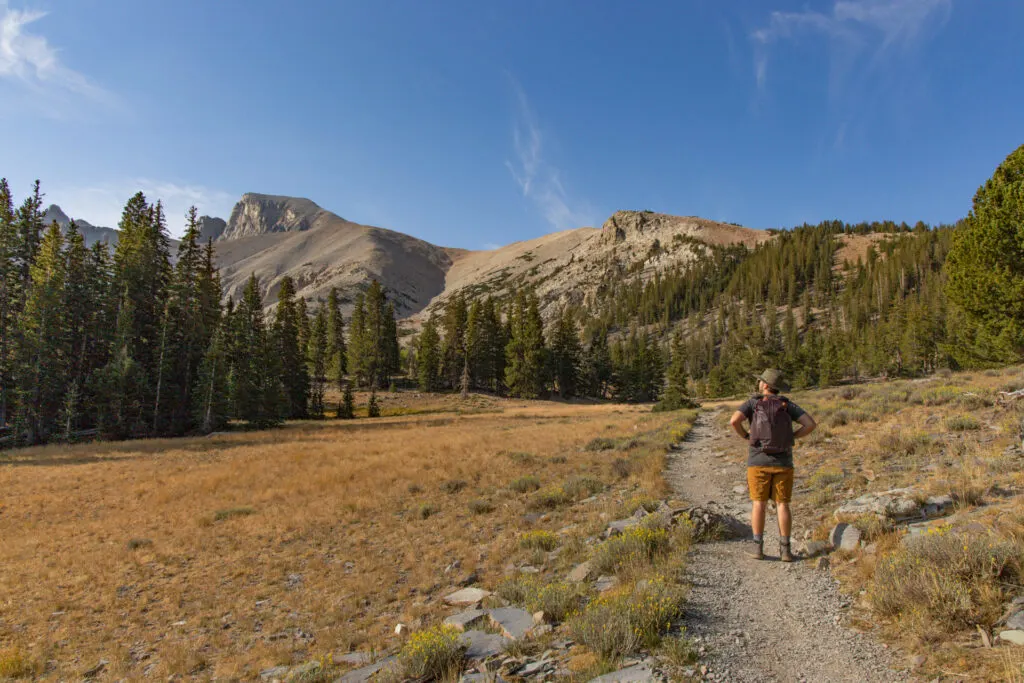
About Peak Design
But first, if you’re not familiar with Peak Design, they’re a Climate Neutral Certified brand that’s as committed to sustainability as they are to making functional bags and accessories for outdoorsy photographers.
Yes, I said photographers. Peak Design is, first and foremost, a brand for photographers. BUT! They’ve been increasingly extending their product lines to include things like travel backpacks and phone cases that are intended to appeal to non-photogs, too.
And this new Outdoor Backpack and Sling line is for everyone. Photographers, non-photographers, photographers who occasionally are not photographers and just travelers or hikers… These bags are designed for all of us. But yeah, photographers are still gonna be the ones who get the most excited about the functionality, especially if they already have plenty of Peak Design gear (like I do).
Bottom line: you don’t have to even own a camera to find this bag useful and functional, but photographers will likely still dig it the most.
What’s in the New Outdoor Line?
So let’s go over some of what makes up this new Outdoor Line:
- A 25L Outdoor Backpack (which we tested)
- A 45L Outdoor Backpack
- A 7L Outdoor Sling (which we tested)
- A 2L Sling
Peak Design also recently released a new version of their Camera Cubes and Ultralight Packing Cubes, plus Flat Hook Straps to attach and customize things, but we’ll talk about those in a minute and why you might want to consider adding those to your cart, too.
But let’s start with the backpack and some of the standout features.
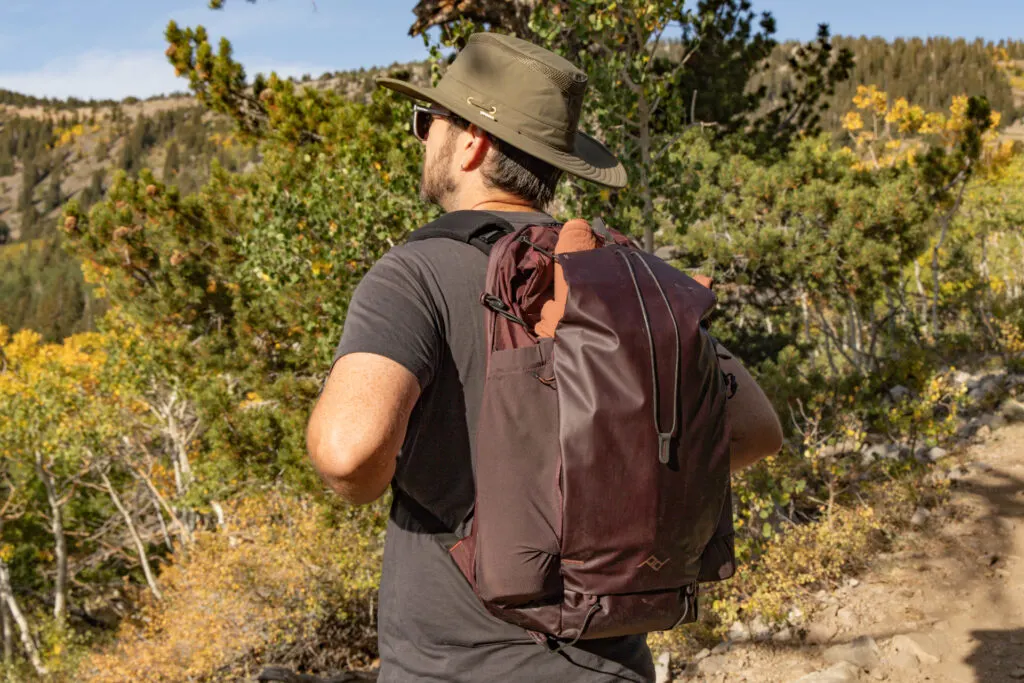
Peak Design Outdoor Backpack
Clever Features:
- Durable front stash pocket
- 2 front zipper pockets with key leash
- Pull to open loop and cinch cord closure
- Cord Hooks all around the bag, plus more inside
- 2 side water bottle pockets (4 on the 45L)
- Removable hip belt with two pockets (comes with the 45L, sold separately for the 25L)
- Laptop sleeve/Hydration reservoir with hose pass-through
- Full-open zippered back access
- Top drop-in access
- Dual removable and repositionable sternum straps
- Shoulder strap pockets
- 4 Capture Clip Attachments points on shoulder straps, plus 1 on hip belt
- Made of recycled materials
- Weatherproof nylon shell that’s Bluesign Approved
- PFAS-free
- Available in three colors

Honest Thoughts:
But what do all these featiures mean in practice, when the Peak Design Outdoor 25L Backpack is actually out in the field? We did a little testing to see if it was all we hoped it would be.
For starters, I dig the fact that there’s a top-down opening on the top so you can quickly and easily grab stuff out of the bag and actually kinda like the lack of zippers. The opening is a sort of roll-topsituation that’s sealed shut by a magnet, so it’s super easy to open and close and just sort of flops down when you release it to seal itself up.
To make sure everything inside stays secure instead of a zipper is a self-locking pull-cord attached to the outside pocket. Pull up and out on the top tab to open it up and pull it out, and pull up on the cord to tighten and lock everything down. The cord is integrated into the front stash pocket, too, which functions super well as a quick place to shover jackets, snacks, even a bike helmet.
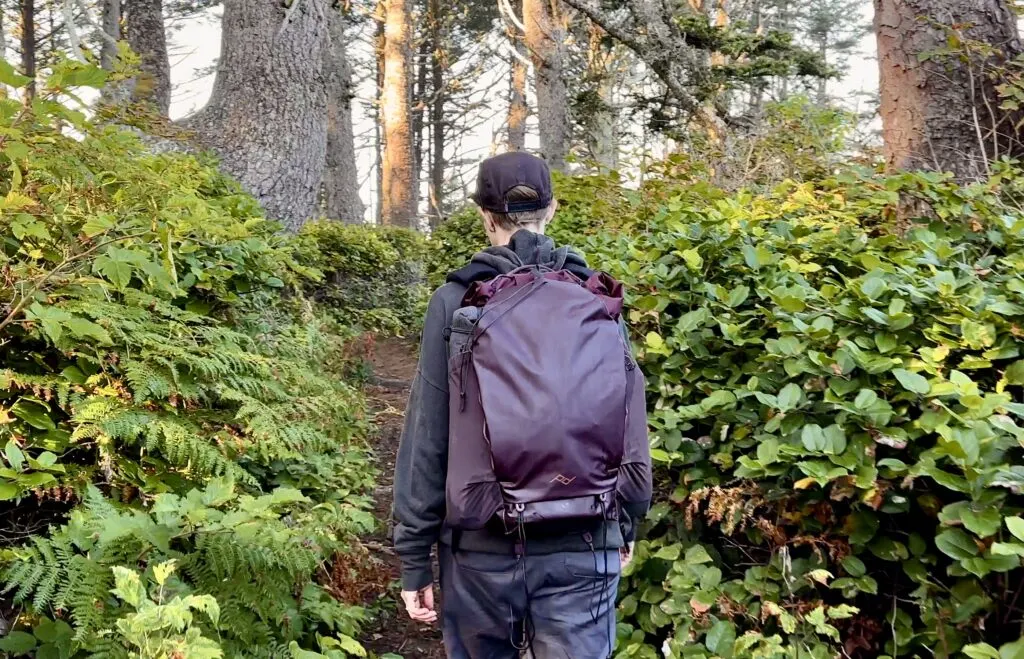
I’m not saying this bag will be as secure as a zipper closure if it really gets turned upside down and knocked around, but it does a pretty good job, and so far, I’ve had no issues with stuff just falling out.
The entire back panel also unzips and opens like a clamshell, hinging at the bottom. That’s where photographers and travelers alike can get excited. Because if you’re packing your bag full of packing cubes and clothing, it’s much easier to get to what you want via an opening nearly the same size as the bag than it is to dig down through the top.
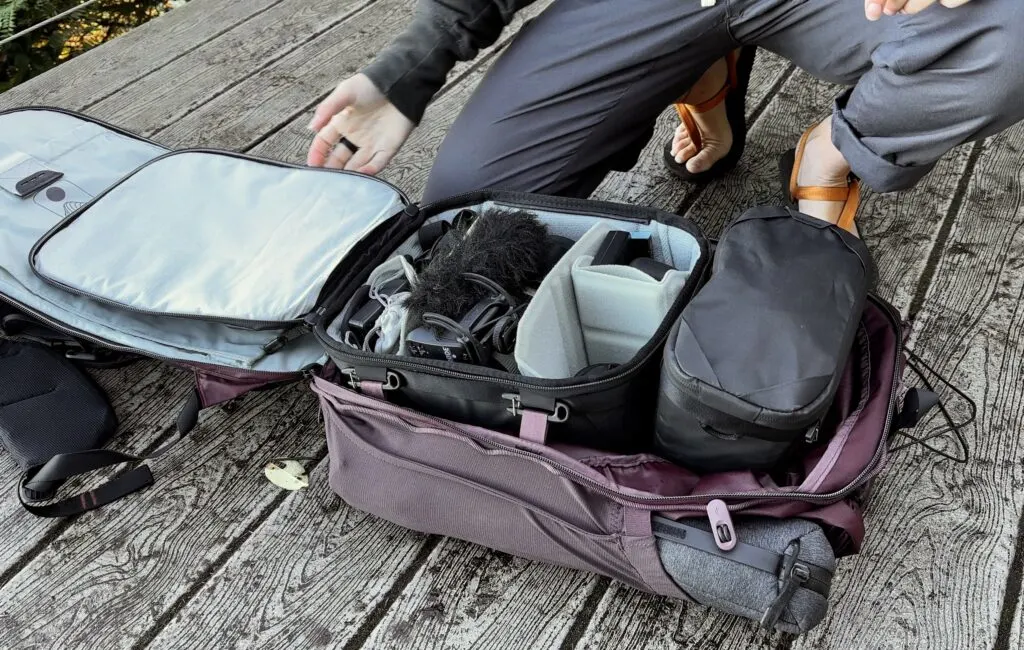
And if you’re carrying camera gear, you want to be able to access all your lenses and flashes and what not. The back panel opening allows that. Plus, there are attachment points for Peak Design’s new camera cubes so you can secure the cubes in place so nothing slides around or falls out, which is a must, because, frankly, I found that when you have the bag face down on the ground and unzip the whole back panel, there’s no internal structure, so the sides just flop to the ground.
This could actually be a bit of a problem if you’re just packing the bag full of loose items or clothes, because if there’s nothing to keep the bag sides rigid, you risk everything falling out when you unzip the whole back. So we say camera cube or packing cubes are highly recommended. Speaking of, the SMedium (that’s not a typo) and Extra Small camera cubes both fit in the 25L. In fact, if you take out the lid insert of the extra small one, flip it around the side and bottom, and place it upright in the top of the bag, you can also use it as a grab-and-go solution for the gear you use most when reaching into the top of the bag. The 45L can fit a wider variety and combo of packing cubes and gear.

The two extra deep stretchy side pockets are a must and I was impressed to discover they fit not only large water bottles, but ALSO the Peak Design Tripod, which we have and love, by the way. That said, on the 25L pack, the pockets are much too high to access while wearing the pack, meaning if you’re hiking and need your water bottle, you’ll have to remove the pack first, which is a bummer. The 45L pack has additional shorter stretchy pockets on the side that better accomodate access to bottles, so I’m not sure why Peak Design didn’t add that feature to the smaller pack, because this is one feature that really puts a damper on useability, honestly, one glaring omission I think they really messed up on.
Moving on, the two zipper pockets, one on each side of the front, are big enough to stash items like phones and small backup batteries, plus there’s a bungee key leash that you can swap to either pocket depending on which shoulder you use to swing the bag around to get into it. Pretty cool.
I also appreciate the lash cords and Cord Hooks on the bottom of the pack–cords you could also relocate to just about anywhere else on the bag–but we’ll get to that in a second. They worked for lashing a jacket, sleeping bag, foam Z-rest, or whatever. They are super long, though, and there’s no little pocket to stash them in when attached and not in use, so your best bet if not using them is to remove them altogether to keep them from dangling and getting in the way and catching on things.
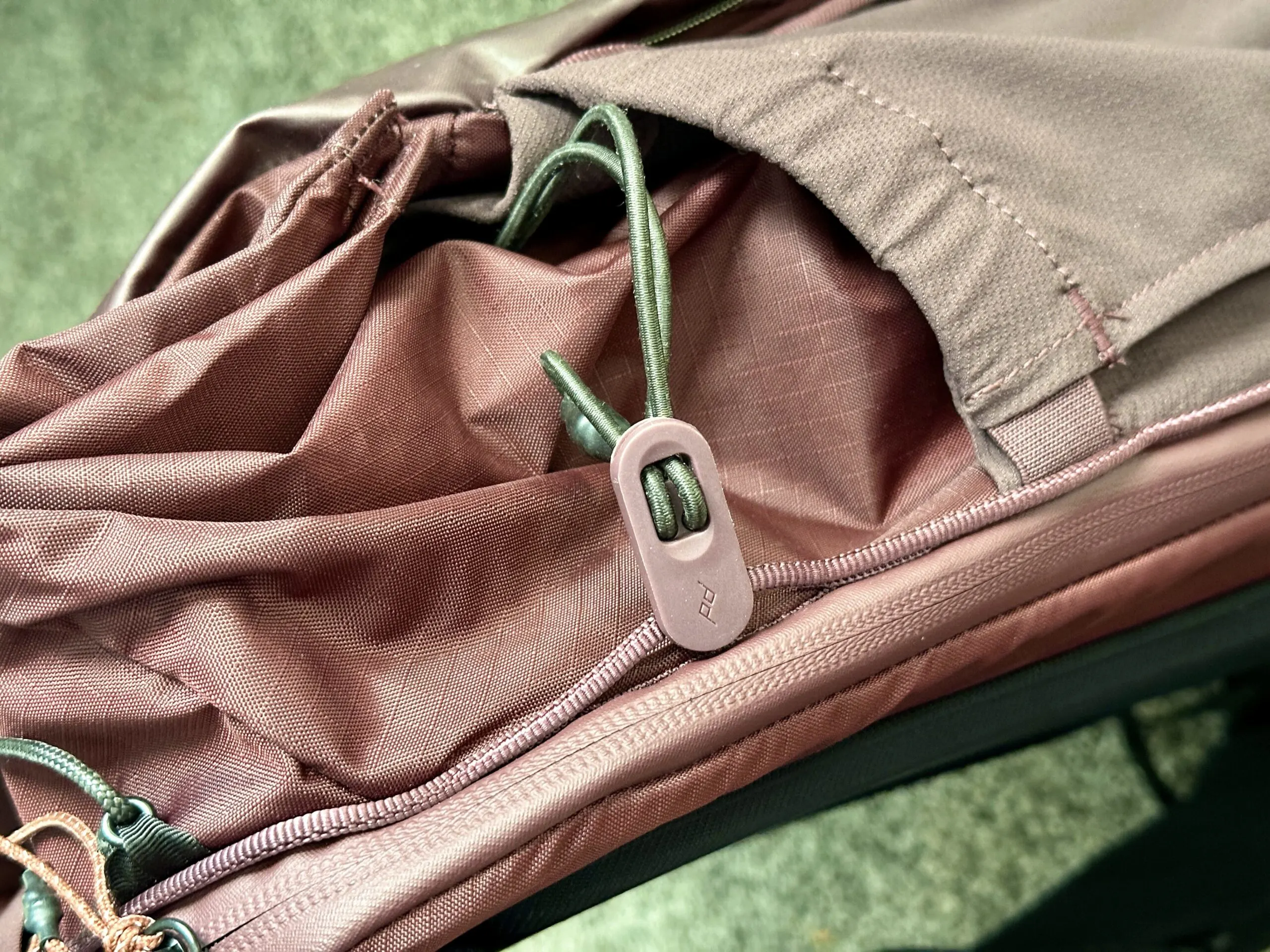
Speaking of repositionable cords, there are also stretchy cords that come installed on each side of the backpack and act as compression straps so you can flatten the bag to almost nothing but can ALSO be moved around to anywhere on the bag.
That’s because this Cord Hook system is literally all over the bag: All around the perimeter, on the front, the bottom, the back, the top, you name it. Even on the inside. And I love this feature, because it means you can create a lash line for drying wet socks, secure extra gear, compress the bag, hang stuff from the inside of the front pocket, even attach accessories like the packing cubes or Outdoor Sling to the outside. They are extremely versatile and customizable. You can also use them as independent attachment points for other things. I clipped my Kula Cloth to one while hiking, for example.
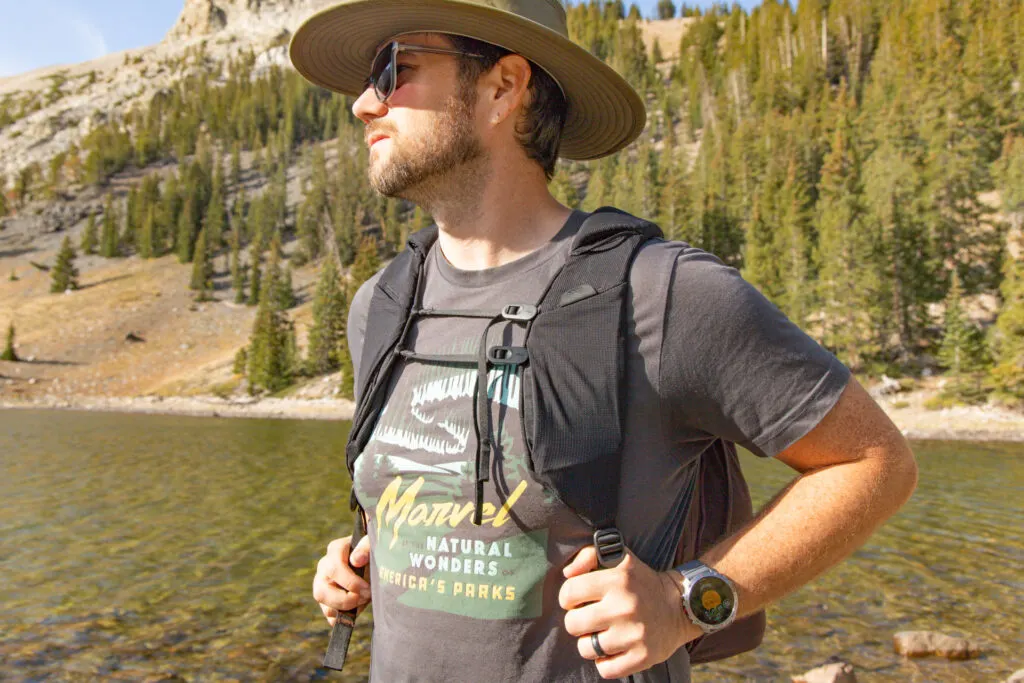
As for the shoulder the straps, I have mixed feelings as a compact human. They have pockets, which I love for quick access to snacks and sunglasses, and are super padded, but rather thick, which means they’re not very flexible. And they’re fairly wide, especially in the middle because they are designed more like running vest straps, so they weren’t the MOST comfy on my small frame and people with breasts, especially if they are also petite, may find the straps especially uncomfortable as they will definitely encroach over sensitive areas.
There are two removable and repositionable sternum straps that also utilize the Cork Loop system–which you can just clip to one side if you want to get them out of the way. But you can also attach either an Outdoor Sling or Ultralight Packing Cube to them using the bungee or Cord Hook straps. That said, that chest mount functionality sounds cooler than I think it will be in practice. I mean, if I am going to wear an extra pouch when I’m hiking or traveling, I don’t really want it on my chest. I’d much prefer it to be a totally detached hip pack.
Because if I’m attaching a pouch to my backpack where sternum straps might be, that means anytime I want to take my backpack off, I have to unstrap the whole pouch first. And then I have a bunch of heavy crap bouncing around on one side of my bag and hanging off precariously while I’m trying to take off and dig through my bag. Plus, again, if you have breasts, you probably don’t really want a bunch of weight bouncing up and down on top of them.
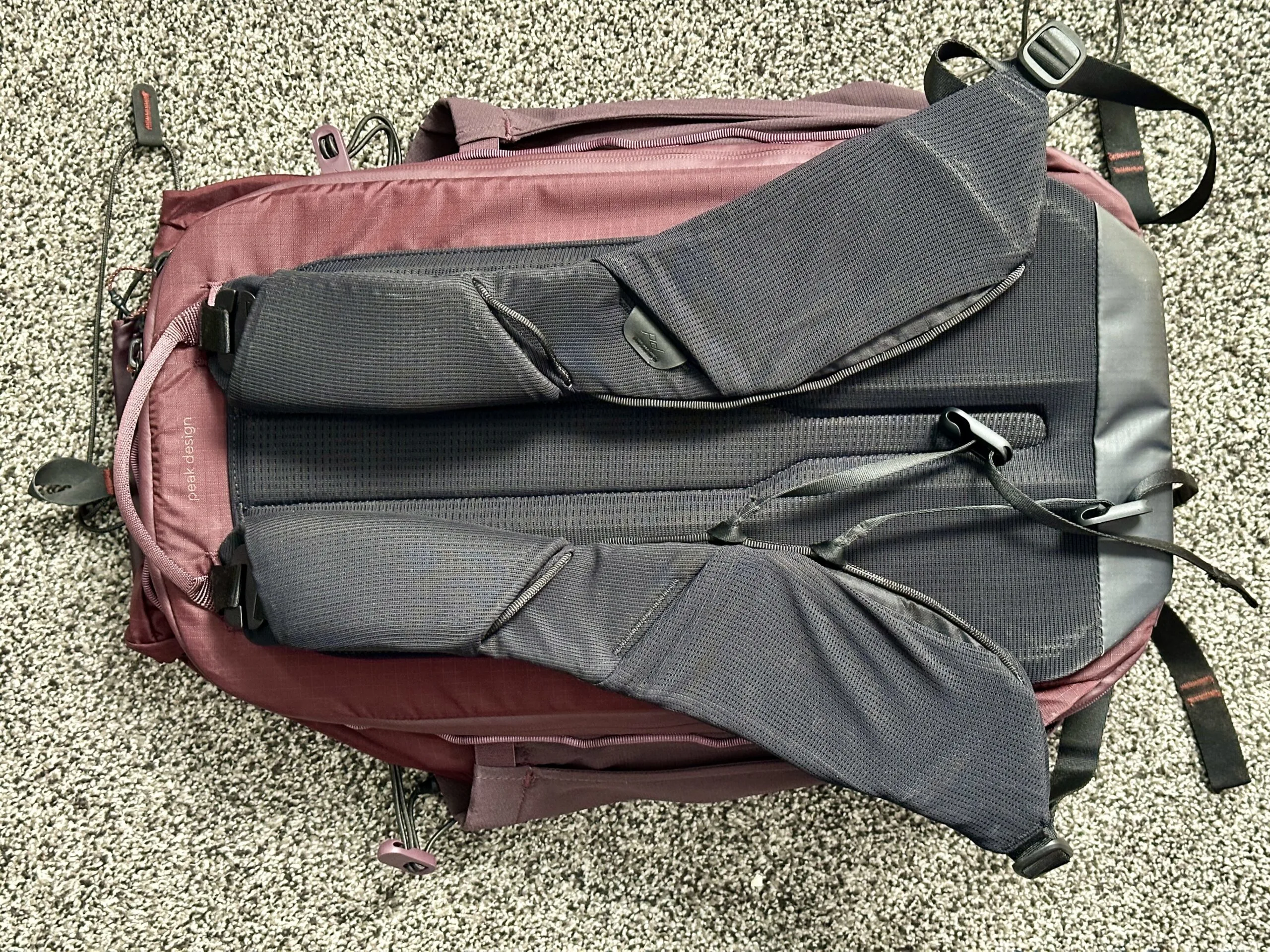
No, to me, it makes a lot more sense to wear one of the slings or even a cube as a traditional hip pack. Alternatively, if you’re using the hip belt with the pack, you can attach the cubes to that instead, which makes a lot more sense, because then it’s essentially an extra hip belt pocket.
The hip belt is super easily removable, by the way, and hinges slightly for more comfy carry. It comes with the 45L, but you’ll have to buy it separately if you get the 25L. I’m actually a big fan of that removeable versatility because sometimes I want a hip belt, and sometimes I don’t. So pop it on, pop it off. You do you.
Speaking of attachment points for accessories, if you have a Peak Design Capture Clip like I do, you can attach it THROUGH–not around–five different attachment points on the pack: an upper and lower pass-through on each shoulder strap–that makes four–And a pass-through on the right hip belt pocket. There’s also a stretchy pocket on that side if you’re not using the clip. And a stretchy zipper pocket on the other.
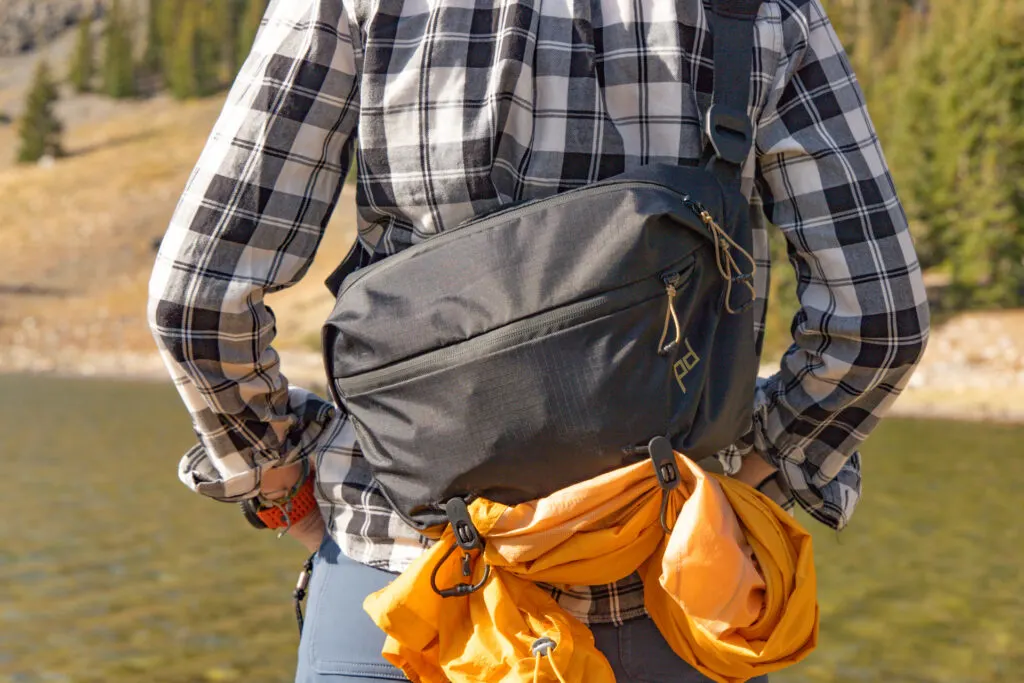
Peak Design Outdoor 7L Sling
Clever Features:
- Grab handle
- Padded adjustable convertible strap
- Can be worn as a sling, a hip pack, or strapped onto the backpack with Cord Hooks
- Front zipper pocket
- Interior zipper pocket with smaller stash pockets inside
- Cord Hook external carry loops and straps for lashing things outside
- Stabilizer strap included on the 7L
- Hidden stash pocket on pack panel that fits most phones
- Weatherproof nylon shell that’s Bluesign Approved
- PFAS-free
- Available in 3 colors
- 7L Sling fits an XS camera cube
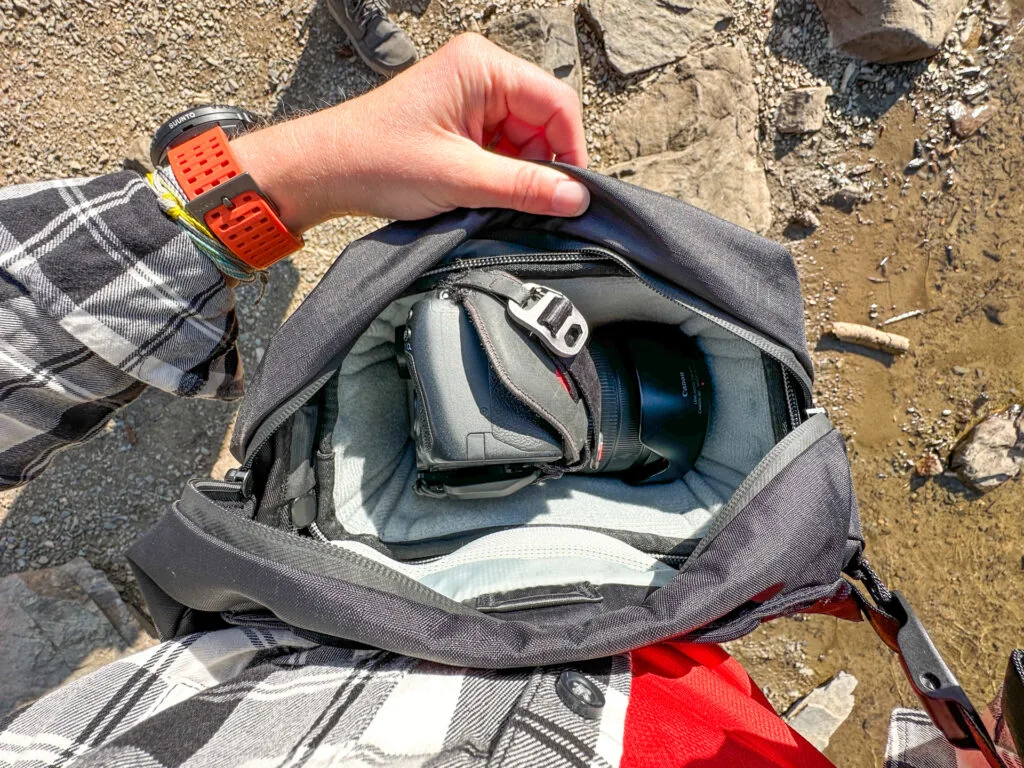
Honest Thoughts:
Right up front, let me say there’s very little I dislike about the 7L Outdoor Sling. In fact, it might be my new favorite piece of minimal carry gear. It’s designed to be carried as a cross-body sling or a hip pack (although if you’re close to my size or smaller, you can’t use it as a waist pack–the strap is too long even cinched all the way down). On the upside, you can swap the orientation of the whole strap so whether you prefer to carry over your left shoulder or your right, you can. Plus, adjustments points are all super easy to use. Josh and I were able to trade it back and forth and in second we had it loosened or cinched to our personal preferences.
The Peak Design 7L Sling is also a near perfect size, plus it has compression straps/bungee attachment points on the bottom so you can cinch it down and it lays flatter when it’s empty, but also offers a great place to lash an extra layer.
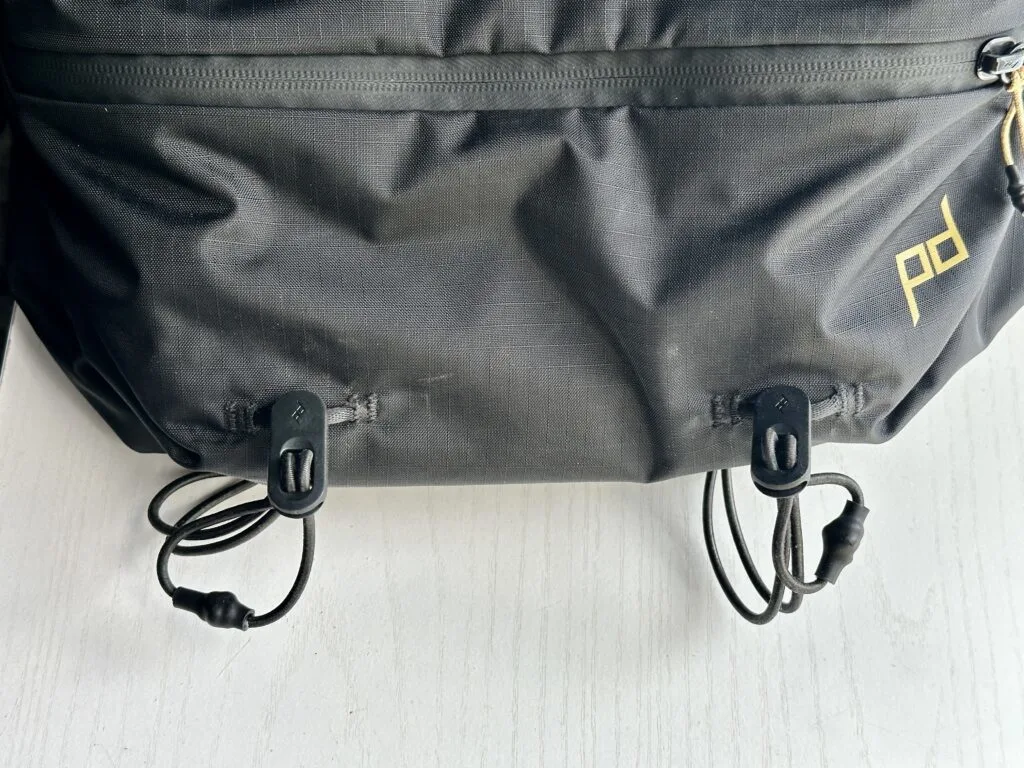
On the inside, there are toooons of little interior pockets for batteries or snacks or whatever you got. Plus, the extra small camera cube ALSO fits in the 7L Sling so you can use it to carry bits and bobs when you’re around town or on the trail, or your camera. My Canon RP and 28-105 lens fit perfectly inside, though with the lens hood attached (pointed out in ready-to-shoot mode), it was a bit of a tight squeeze. But there was still room in the exterior and interior pockets for a snack, extra camera batteries, my keys, cell phone, backup battery, and other small essentials like hand sanitizer.
Honestly, this is going to be my new go-to sling for travel because I can use it as a lightweight carry option when hiking, wandering through town, or biking, with or without my camera gear. It’s fantastically versatile. I like it even better than the original Peak Design Sling, which I’ve been using for years. This one is lower profile, packs flat for travel, and is more versatile since I can use it with a camera cube or without.
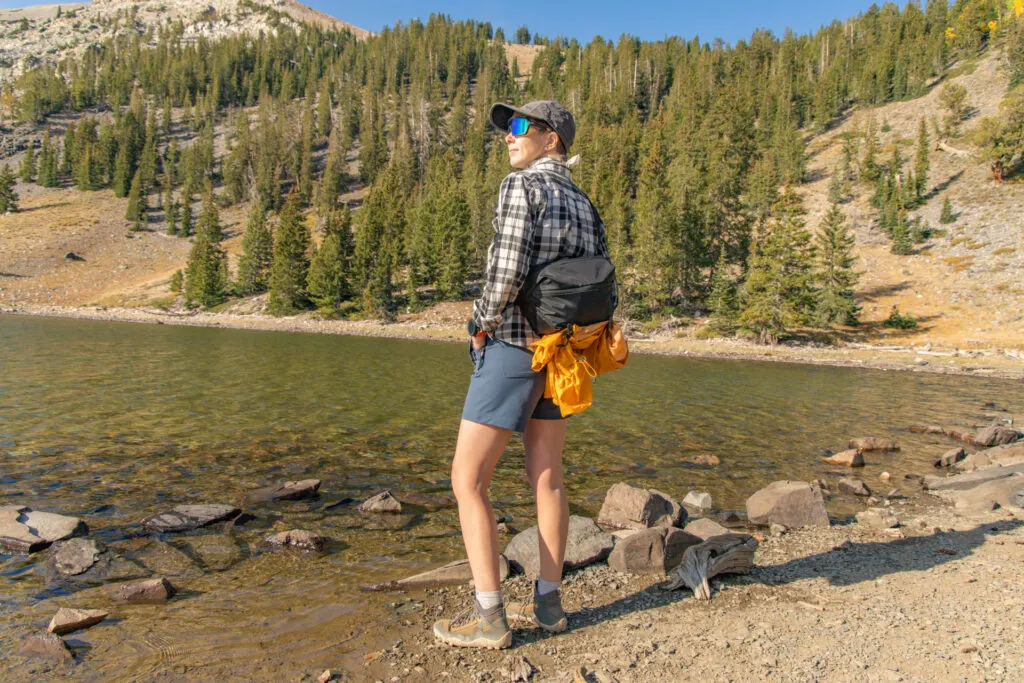
Bottom Line
Is the new Peak Design Outdoor Line perfect? Well, not *quite*. I mean, they certainly thought of just about everything and It’s almost a perfect marriage of streamlined versatility and functionality for those who like to travel, hike, and carry camera gear. And nothing seems to be lost from trying to make these bags more travel friendly.
They’re not ultralight, but they’re light, pack down small, carry camera or hiking gear super well, are durable AND come with a lifetime warranty. Will this be the backpack I reach for first for hiking trips near home? Probably not just because the straps are bulky, I can’t reach a water bottle, and it’s a bit overbuilt for most short dayhikes. But will it be the pack I reach for when I’m traveling with my camera gear? Absolutely, because it’s one bag that does it all, which means I don’t have to pack extra backpacks for different types of excursions.
Honestly, this might be my new go-to pack for the type of travel where I might sometimes have my camera gear, sometimes not, am planning hikes and city strolls, and need a durable bag that can do it all (and counts as a carry on–45L–or personal iem–25L). It really is that good. And the 7L Sling is already a staple: it can carry my camera or a water bottle and enough supplies for an easy hike (or just around-town essentials).
And I can’t wait to see what costomizations I manage to come up with for all the pack attachment points. This is gonna be fun. So go check out the bags HERE, grab your camera gear and wander on.
